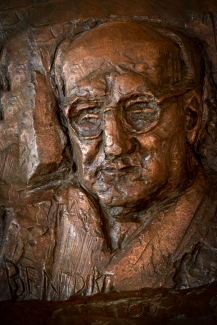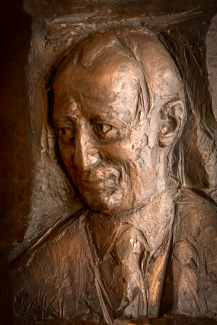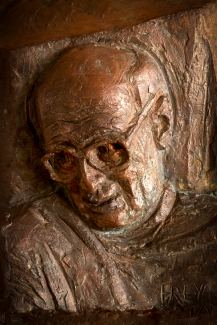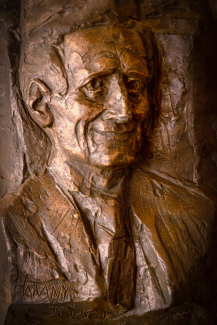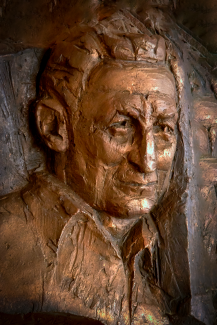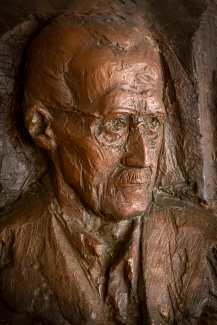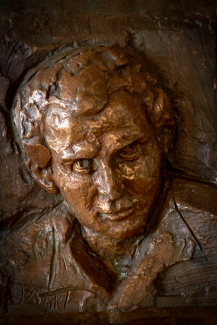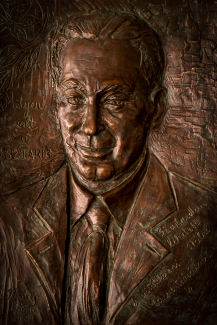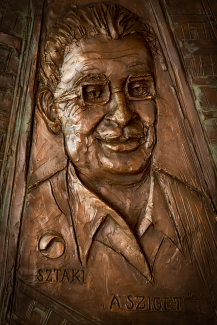- SZTAKI
- About us
- Pioneers
Our Greats
Our institute’s predecessor, the MTA Automation Research Institute (AKI), was founded in 1964. In 1973, MTA AKI merged with the MTA Computing Center (SzK) and adopted the name MTA SZTAKI. Since 2019, our institute has been part of the Eötvös Loránd Research Network (ELKH), and since 2023, it operates under the name HUN-REN SZTAKI (HUN-REN Institute for Computer Science and Control) as a member of the HUN-REN Hungarian Research Network.
Our portrait gallery will present you a short presentation in commemoration of ten, very productive scientists, all having played once decisive roles both at our start and our later evolution. They are Ottó BENEDIKT, Frigyes CSÁKI, Tamás FREY, József HATVANY, István RÁCZ, Rezső TARJÁN, Miklós UZSOKY, Tamás ROSKA, Péter INZELT and Tibor VÁMOS. They belong to the generation of outstanding Hungarians, pioneers in computer science and automation, whose activity was associated with the two predecessor institutes. Some were also active for some time in the new Institute. Photographs of the reliefs of the scientists displayed on the walls of the institute's great boardroom in Kende Street precede the short texts about each researcher.
We are proud of them for having worked for our Institute. Remember them, learn about them and learn from them!
Ottó Benedikt (1897-1975)
One of the founders of the Research Institute for Automation and its first director.
His life was shaped by the historic events of the first half of the 20th century. In 1919 he was forced to emigrate, so he graduated at the Vienna Technical University. In 1932 the Soviet Government invited him as technical advisor and university professor. Here he attained significant results in the development of the special electric machines. One of his most important inventions was the controlled electric machine called autodin that combined in a single machine the tasks of three, becoming an especially important component of the electric-driven machines. The new invention had great international success. Benedikt's greatness as an engineer is demonstrated by the fact that when rotary drives were replaced by semiconductor controls, he was able to abandon the subject and support new topics at the institute. He has also produced excellent work in the calculation of highly saturated magnetic fields.
After his return to Hungary (1955) he became professor of electrical machines at the Technical University of Budapest and established an independent research group in the department. The group became the academic Research Group for Automation in 1960, then later in 1964 the Research Institute for Automation. He selected his direct colleagues with excellent instinct. As a result, a valuable collective of young talented people was formed in the Institute.
Benedikt participated both in the life of the Institute and the public life of his science even after his period as active manager had terminated. He was one of the initiators of the establishment of the National Committee of Technical Development (OMFB) where he was member of the Presidium until his retirement.
For his lifework he received the Kossuth Prize in 1958.
Frigyes Csáki (1921-1977)
The first great personality of the automation theory in Hungary, whose influence is still pertaining even after his death. One of the founders of the Research Institute for Automation, HAS and also its deputy
scientific director, later Vice President of the Hungarian Academy of Sciences (1976). In 1973 he was awarded the State Prize for his accomplishments in the theoretical development of the automation discipline, especially in his outstanding work “Modern control theory, non-linear adaptive systems”. His theses written on topics of electro-technics and control technics are of fundamental relevance by international standards as well. Among many prestigious positions, he was also the chairman of the Hungarian National Committee of Pugwash.
He played an important role in the modernisation of higher education in Hungary as well as in the development of the disciplines of automation, process control and control theory. He has written several books, some of which have been translated into German and English. These books were regarded for a long time as basic works for both education and research purposes. As a pioneer of his science, he has recognised the relevance of several new scientific trends, still in their early phases. As the rector of Budapest Technical University, he became one of the modernisers of electrical engineering education. He maintained good personal relations with the staff of the Institute, and as a university leader he also strongly supported the cooperation between the Institute and the university in the field of scientific research.
Tamás Frey (1927-1977)
PhD in Mathematics, director of the Centre of Computer Technics, HAS, later head of a scientific department at the Research Institute for Automation, HAS. He has accomplished his most important results in the approximation theory, the differential equations, the numeric analysis and the algebra of automation. In the field of applied mathematics, he has contributed substantially to the development of special mathematical methods in biology and medicine, especially in medical diagnostics. He perfected the computer-aided processing of the cardio-electric signals.
He came to the Research Group of Cybernetics, HAS, as a reputed mathematician and shortly after its reorganisation into a research institute he became the director of the Centre of Computer Technics. It was during his management period that the role of the mathematical applications of computers increased considerably. His professional knowledge, exactingness and human authority have served the reputation of the whole of the Centre. In 1968 he received a Chair at the Budapest Technical University, where he played an eminent role in teaching the mathematical foundation of computer theory. In parallel to this, he also acted as a scientific advisor at the Research Institute for Automation and later took over also the department for the theory of control technics. He has built around himself a very strong team of mathematicians, among them a number of young talents, many of whom made a remarkable professional career later.
József Hatvany (1926-1987)
Head of a scientific division of the Institute. He received the State Prize in 1978 for his achievements in the development and production of CNC machines in Hungary.
He was the most significant pioneer of computer-aided design and manufacturing in Hungary and an expert with extraordinary international influence. Before and during WWII he was a pupil at a prestigious college in England, later studied physics at Cambridge becoming an alumnus of Trinity College. Here he has acquired an immense background of knowledge and capacity of thinking in human sciences. He returned to Hungary in 1947 where his special capabilities were utilised in many ways. Both during the Rákosi era and after 1956, he suffered persecution, was imprisoned and then had difficulty finding employment. From 1964 on he worked at our Institute, and this period has become the most productive stage of his career. Due to his extensive professional knowledge and international relationships, he was able to recognise the relevance of the latest and most promising trends and he introduced them successfully in the Institute. As an early and unique achievement even in Europe, he developed computer-controlled graphic devices and three-dimensional CNC systems. He implemented the complete integration of all phases of computer-controlled production in test factories simulating real-life environments. He created a still-existing scientific school by gathering and educating a group of talented young people providing them scholarships and studies abroad which offered them at that time an exceptional opportunity for their professional career development.
István Rácz (1922-1991)
Creative mind of European authority on controlled electrical drives, doctor of engineering, and head of the scientific department of the Institute. In 1975 he was awarded the prestigious State Prize for "his activity in the field of theory of asynchronous motors controlled through thyristors and their real-life applications."
As an extremely talented engineer, his outstanding theoretical knowledge was combined with extraordinary inventiveness in practical engineering. In his research field, i.e. in the investigation of the dynamic features of electric machines, he also had results highly ranked even by international standards. His books are considered basic literature in the field even at present, to mention one example, "The Transient Phenomena of Electric Machines", with the co-author Pál KOVÁCS published in 1954, was translated into several languages and is still being read in our days. The basics of vector theory of AC machines were elaborated by them in co-operation with their colleagues. István RÁCZ preceded his age by developing several of his applications, e.g., the application of thyristors had been demonstrated years before their invention by simulating the then non-existent heavy-current semiconductors by contactors, for the stepping operation of induction motors. Later, in a similar depth and quality he dealt with the automation of electric drives and, relatedly, with the application of up-to-date power-electronic elements. In his scientific work he actively made use of computer technology from as early as its existence, and with his particular knowledge of mathematics further developing the methods in this field.
He joined research work in automation carried out at the Technical University of Budapest in his youth, and later, besides his activity as a professor at the university, he acted as a head of the department at the Research Institute for Automation (AI), then later at the Computer and Automation Research Institute (SZTAKI). Under his scientific guidance, the SZTAKI became an outstanding school in power-electronics in the international arena as well. Among other things, he and his colleges have developed the vector theory of controlled AC drives. Through his outstanding scientific activity and international reputation, he greatly contributed to the fame of our Institute.
Rezső Tarján (1908-1978)
Mathematician and physicist, graduated in Vienna. He was one of the key persons in helping the Hungarian electronic industry revive after 1945. In the Stalinist Rákosi era, he was imprisoned by false charges; after his release, he became one of the Hungarian pioneers of computer technics, a novelty just emerging all over the world. He was appointed to head the Research Group of Cybernetics, one of the predecessors of the current Institute. Here, he had an eminent role in the construction and adaptation of the first Hungarian computer called M3 as well as launching its first utilisation projects in various scientific areas. Around him has formed a school consisting of talented young people where the later leading experts of Hungarian computer technology were trained. After 1960, getting tired of the short-sighted fighting of his time and also bearing the consequences of former physical stresses he retired from his position and was acting until his death as the advisor of the National Committee of Technical Development (OMFB). He was moreover, the founder and first Chairman of the John von Neumann Computer Society.
Miklós Uzsoky (1925-1995)
He was one of the most genial figures in the history of Hungarian electronic research and development. At the time of the complete closure of the country – intellectually as well as in any other aspects – he created such innovations which at that time had their equals in the US only. They were the backward waves, the specific filters of digital technology and many other achievements that survive today as historic memories only due to partly the peculiar circumstances of his age and partly the general progress we witnessed. Uzsoky developed the first Hungarian television transmitter, and a microwave transmission system – the most profitable export product of the Hungarian industry over a long period – was created under his leadership. At our Institute he was a pioneer of computer-aided electronic design, production, and production control and testing. Various equipment developed by him had been exported by the Institute. Furthermore, he developed modems – very advanced ones at that time – which were impossible for Hungary to procure from abroad. They were the first key products to build a computer network in the country. He possessed an unparalleled knowledge of mathematics, physics and engineering and a similar capacity for creativity. He was awarded the State Prize in 1973 for his achievements in laying down the basics of computer-aided design and development technology in the electronic industry.
Tamás Roska (1940-2014)
Bolyai-, Széchenyi-, Dénes Gábor- and Prima Primissima Prize-winning academician, chairman of the Scientific Council of the Institute, head of the Research Laboratory of Dual and Neural Computing Systems, founder of the Faculty of Information Technology and Bionics at Pázmány Péter Catholic University. As a young researcher, he focused on circuit theory as well as the theoretical issues of efficient construction and interconnection of multi-core computers on silicon, and the task sharing and communication between processors. In the 1980s, his attention turned to information processing in wildlife. In collaboration with research groups in neurobiology, circuit theory and circuit design from Hungary, Western Europe and overseas, he developed and patented the analogical computer architecture, based on the vertebrate visual system, in which the duality of human analytical and logical thinking was present. The resulting retina-inspired analogical vision chips were the most efficient image sensing and processing computers of their time. The Bi-i industrial vision-processing computer based on this chip won the Product of the Year award at the Stuttgart Industrial Fair in 2003. The basic elements and layouts of the analogical microprocessor are still the building blocks of many modern artificial intelligence systems. He had a fantastic ability to connect. Thanks to his great erudition, his knowledge of people, his positive outlook and his genuine curiosity, he was able to find a topic that interested him and his conversation partner after a few sentences. He believed that the truths of science, the arts and faith combined bring us closer to understanding "the world of man". His talent for creating schools was also extraordinary. He dreamed up, founded and built a research university faculty and a doctoral school at Pázmány Péter Catholic University, where students learn the basics of neurobiology alongside computer science. Tamás Roska has also been awarded the Order of Merit of the Hungarian Republic’s Middle of Cross with the star and the Order of St. Gregory the Great, the highest honour awarded to laypersons by the Vatican.
Péter Inzelt (1944-2019)
The director of the Computer and Automation Research Institute, Hungarian Academy of Sciences (SZTAKI or Institute), the founder of the modern Institute after the political regime change, who led the Institute for 21 years. After graduating in 1968, he joined the Research Institute for Automation (AI), of the Hungarian Academy of Sciences as an academic intern in the Department of Continuous Process Control. Recognising his outstanding professional and managerial skills, his managers entrusted him with increasingly important tasks, making him the head of the scientific department of the Institute from 1981, then deputy director of the economic department from 1987, and director of the SZTAKI from 1993 until his retirement in 2015.
He is credited with the preparation and implementation of one of the country's first successful World Bank tenders, but it was under his leadership that the Institute joined the prestigious ERCIM (European Research Consortium of Informatics and Mathematics) consortium, the first of the former socialist countries to do so and won the Centre of Excellence award in 2001. He considered it important to develop international contacts and to introduce SZTAKI to the international tendering arena.
Under his direction, the Institute has been renewed both in its internal structure and its external appearance. Under his direction, the Institute's building on Lágymányosi Street was constructed, and the headquarters on Kende Street with the premises on Victor Hugo Street were renovated.
His work has been recognised with numerous awards and distinctions, including the Order of Merit of the Hungarian Republic’s Officer's Cross (2003); the Széchenyi Prize (2007); the MTA Pro Scientia Hungarica Medal (2014); the Order of Merit of the Hungarian Republic’s Middle of Cross civil branch (2015); and the Neumann Prize (NJSZT, 2015).
"As for me, I was happy and glad to be a director for 21 years, up to the age limit, and I tried to serve the institution well. I hope there are some of you who feel the same way. I wish the Institute, my successor, all its directors and staff every success in the future." (Thoughts of Péter Inzelt in Zsuzsa Szentgyörgyi: The Island)
Tibor Vámos (1926-2021)
Co-founder of the MTA Automation Research Institute and founder of SZTAKI.
As founding director, he managed to make SZTAKI an island, largely freeing its employees from the negative influences of the outside world. Although he was a man of technology, he was as familiar with the Greek classics as he was with modern art and contemporary music, and he understood the language and aspects of the social sciences. He was always seen as a link between science and industry.
Tibor Vámos was born in Budapest on 1 June 1926. He graduated from the Madách High School in Barcsay Street in 1944. In the same year, he was deported to Fertőrákos for labour service, from where he escaped and was sent to a military prison. In his teens, he wanted to be a mathematician-physicist, but - in his own words - after meeting some real talents, he switched to electrical engineering, which also promised to have a mathematical-physical background. In the spring of 1945, he enrolled at the Budapest Technical University, graduating in 1949.
He wrote his candidate thesis in 1958 on the load control of drum coal-fired boilers. His interest soon turned to the just-developing field of computer science. From 1958 to 1964 he was head of the Automation Department of the Hungarian Academy of Sciences. In 1964, together with Otto Benedikt and Frigyes Csáki, he founded the Institute for Automation Research of the Hungarian Academy of Sciences, one of the predecessor institutions of today's SZTAKI. In the same year, he defended his academic doctoral thesis on the dynamic behaviour of power plants and energetic systems in the inland application of computer methods. Under his leadership, in 1974 the Research Institute for Automation, Hungarian Academy of Sciences (AI, HAS) was merged with the Centre of Computer Technics, Hungarian Academy of Sciences (CC, HAS) to form the present Computer and Automation Research Institute (SZTAKI), of which he was director from 1964-1985 and from 1986 he was chairman of the Institute's Council, professor emeritus.
In addition to his research career, he has also had a distinguished academic career: from 1969 he was a professor at the Budapest Technical University, and from 1990 he was chairman of the Board of Trustees of the Central European University's Science Programme. From 1992-1993 he was a Distinguished Visiting Professor at George Mason University, Fairfax/VA, and in 1993 and 1994 he was a Distinguished Affiliate Professor at George Mason University.
